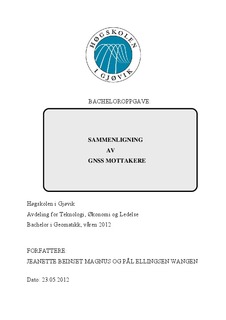| dc.contributor.author | Magnus, Jeanette Beinset | |
| dc.contributor.author | Wangen, Pål Ellingsen | |
| dc.date.accessioned | 2012-08-02T09:36:22Z | |
| dc.date.available | 2012-08-02T09:36:22Z | |
| dc.date.issued | 2012 | |
| dc.identifier.uri | http://hdl.handle.net/11250/143521 | |
| dc.description.abstract | NORSK: Innenfor landmålingsfaget har GNSS eller «Global Navigation Satellite Systems» lenge vært
utbredt som arbeidsverktøy. Med økende nøyaktighetskrav er det viktig at mottakerne leverer like
resultater. Produsenten oppgir målenøyaktighet, men dette er testet under ideelle forhold i
laboratorier. Tidligere kunne de mottatte signalene testes gjennom å benytte en splitter for å dele
signalene fra flere antenner inn på én mottaker for å se etter eventuelle avvik.
Dagens teknologiske utvikling har gjort det vanligere å lage antenner og mottaker i en og samme
enhet, noe som vanskeliggjør en slik testprosess. Denne oppgaven vil lage en testprosedyre for å
teste mottakere. Dette vil innebære statiske målinger over tid for å samle data, samt å lage en
teoretisk simulert splitting av antennesignalene.
På denne måten kan man avsløre forskjeller mellom antennene etter samme prinsipp som tidligere
har blitt brukt for å sjekke GNSS-antenner. | no_NO |
| dc.description.abstract | ENGELSK: Within the surveying profession, GNSS or "Global Navigation Satellite Systems" has long been
widely used as tools. With the increasing accuracy requirements it is essential that receivers
deliver similar results. The manufacturer specifies the measurement accuracy, but they are tested
under ideal conditions in laboratories. Previously, the received signals were tested by using a
splitter to split the signals from multiple antennas into a single receiver to look for any
discrepancies.
Today's technological developments have made it more common to make antennas and receiver in
one unit, which makes it difficult to test signal reception using this method. With this project the
aim is to make a test procedure to test the receivers. This will involve static measurements over
time to collect data and to create a theoretical simulated splitting of the antenna signal.
In this way it should be possible to detect differences between the antennas using the same
principle that has previously been used to check the GNSS antennas. | no_NO |
| dc.language.iso | nob | no_NO |
| dc.subject | GNSS | no_NO |
| dc.subject | landmåling | no_NO |
| dc.subject | statiske målinger | no_NO |
| dc.subject | antennetesting | no_NO |
| dc.title | Sammenligning av GNSS-mottakere | no_NO |
| dc.title.alternative | Comparing GNSS-receivers | no_NO |
| dc.type | Bachelor thesis | no_NO |
| dc.subject.nsi | VDP::Mathematics and natural science: 400::Geosciences: 450::Geometrics: 468 | no_NO |
| dc.source.pagenumber | 112 | no_NO |
